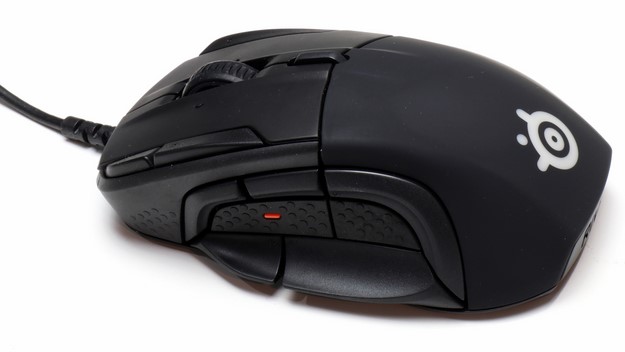Gaming Mouse Roundup: Corsair Sabre RGB, G.Skill RIPJAWS MX780, SteelSeries Rival 500
Steelseries Rival 500 Gaming Mouse
With the Rival 500, SteelSeries wanted to design a mouse that was geared towards thumb movements and mapped button layouts. With 15 programmable buttons, this mouse has the most complicated layout in the roundup, but don’t let that intimidate you. SteelSeries takes pride in their “flick down switches” which are located under the upper joint of your thumb when gripping the mouse. The time it takes to flick your thumb down is reportedly faster than actuating a primary button with a traditional pressing motion.
We found the Rival 500's thumb buttons useful for fast-paced games, but if they aren’t found to be useful for you personally, they can be deactivated with the switch on the bottom side of the mouse. Your thumb will also have access to four other programmable buttons placed above the flick down switches. The rest of the buttons are placed in traditional pointer finger locations, behind the scroll wheel, and on the right side of the right click pad.
What really makes this mouse unique is its tactile feedback engine. In terms of performance, we found the amount of buttons overkill for most games. However, SteelSeries incorporated a vibration mechanism which users can program to specific alerts. For example, health, ammo, stuns, mana, and headshots can be mapped to specific vibration patterns.
This mechanism is located in the center of the mouse, and effectively vibrates your hand when triggered. The Rival 500 features two programmable RGB locations, one of which is the scroll wheel, and the other being the logo on the palm rest. This mouse felt the biggest out of the three and fills up your palm when gripped. That being said, if you prefer a narrower mouse, you might want to look elsewhere. Also, the Rival 500 is constructed with a rubberized palm rest which attracts oils and smudges. This finish gets worse with use and it deteriorates over time. It also does not feature a braided cable, which may be a con for some users. The sensor is a PixArt PMW3360 Optical, with a DPI sensitivity range of 100 to 16,000 DPI with 5 programmable settings. We did not notice any lag or cursor jumping with this mouse, and the movement was smooth and very accurate. If you prefer a high DPI (10,000+), the Rival 500 technically has better specs than the other two mice in this roundup. However, higher DPI does not always mean better performance or more precision. More on this later.

SteelSeries' software, the Engine 3, can be used to configure your mouse or other SteelSeries products. Engine 3's functionality was very similar to the others but we felt the user interface is somewhat cluttered, causing initial confusion. However, it is very full-featured. The GameSense tab handles the settings for supported titles, where the user can customize the mouse for specific games. The software does, however, have a low footprint, using only about 17.1 MB of RAM and less that 1% CPU when running in the background.
At $79.99, the innovative layout and sheer number of buttons on the SteelSeries Rival 500 may not be worth the extra money for users that don't require them. However, it is one of the most feature-rich and accurate mice of the bunch. If you really need all those buttons, the other two rodents in this round-up will leave your trigger happy fingers wanting more.








